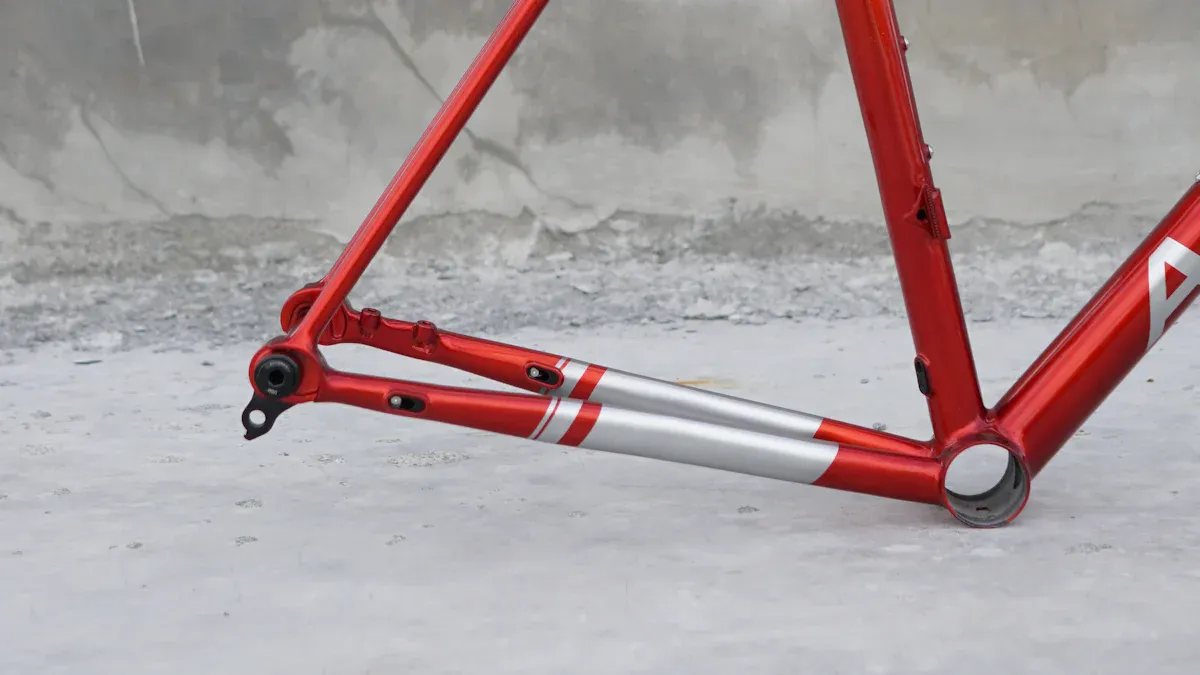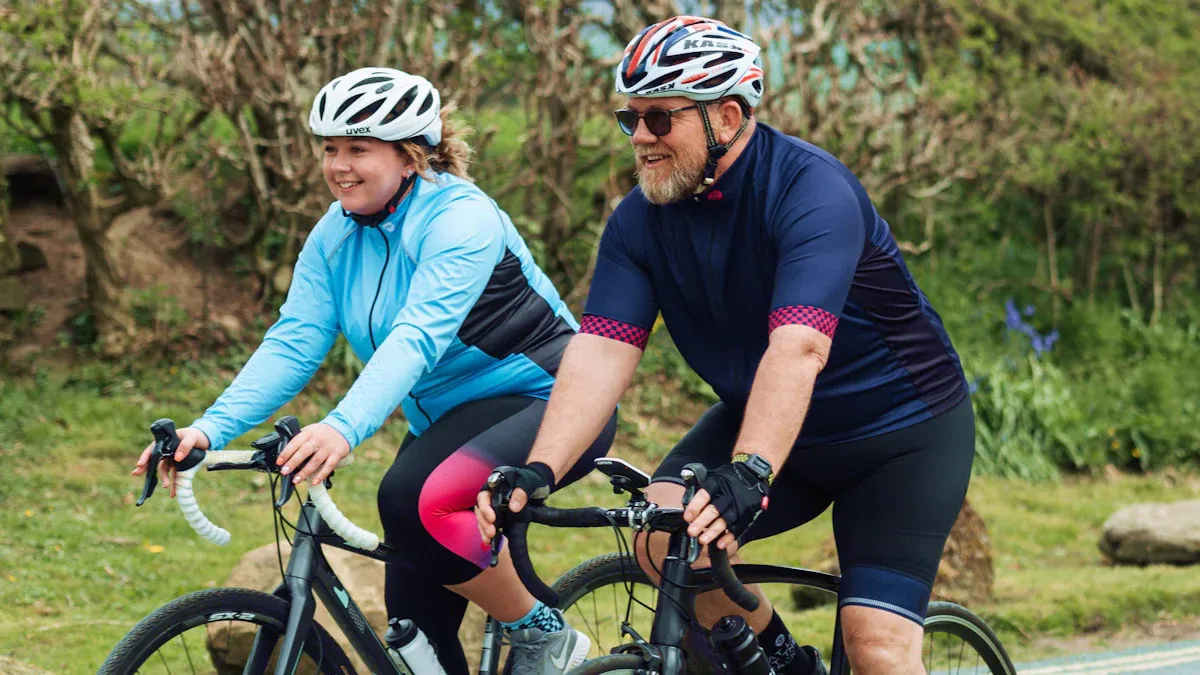
Want to get the right bike frame size? You just need to grab your measurements and use a bike frame fitting chart. Focus on your inseam and height. That’s the secret to finding a fit that gives you comfort. The importance of sizing helps you ride with a proper fit every time. Your bike fit matters!
Key Takeaways
Measure your inseam with care. Use a book between your legs. This helps you find the right bike size. It also makes sure you have a safe standover height.
Use a bike frame fitting chart. Match your inseam and height on the chart. This helps you pick the best frame size. It works for your bike type and how you like to ride.
Adjust your saddle and handlebars to fit you. Make sure they match your body and riding style. This gives you more comfort. Ask a professional for help if you need it.
Measure Inseam for Bike Size

How to Measure Inseam
Getting the right bike frame size starts with measuring your inseam. This step is key for bike sizing and helps you avoid incorrectly sized bikes. You can measure bike size at home with just a few simple tools. Here’s how you do it:
Stand barefoot on a hard floor with your back against a wall.
Wear tight-fitting shorts, like cycling or yoga shorts, to get an accurate measurement.
Place a large book or flat object between your legs, pressing it up against your sit bones and the wall. This simulates sitting on a bike saddle.
Ask someone to measure from the top of the book down to the floor. Try to be as precise as possible.
Take a few measurements and use the largest number as your inseam for bike sizing.
Your inseam is more important than your height for bike sizing. It directly affects your standover height, which is the space between the ground and the bike’s top tube. Proper standover height keeps you safe and comfortable when you stop or get off your bike.
Tip: For road and hybrid bikes, aim for 1-2 inches of standover clearance. For mountain bikes, 2-4 inches is best.
Common Mistakes
Many people make mistakes when measuring their inseam for bike sizing. Here are some things to watch out for:
Measuring with shoes on can give you the wrong number.
Not standing straight or keeping your feet too close together can mess up your measurements.
Using bulky pants instead of tight shorts can make your inseam seem longer than it is.
Skipping the book or not pressing it up firmly can lead to an incorrectly sized bike.
Measuring your inseam the right way helps you find the perfect bike sizing and keeps you safe from discomfort or injury. Always double-check your measurements before you use a bike frame fitting chart to measure bike size.
Use a Bike Frame Fitting Chart
Read the Chart
You have your inseam and height. Now it’s time to use a bike frame fitting chart. These charts help you with bike sizing by matching your measurements to the right frame size. Most sizing charts show a range of heights and inseams next to recommended frame sizes. Always check the chart from the bike brand you want, since sizing can change between brands.
Here’s a quick look at how sizing charts differ for each bike type:
Bike Type | Units Used | Frame Size Range Characteristics |
|---|---|---|
Mountain | cm and inches | Smaller frame numbers for the same height; sizes in cm/inches |
Road | cm | Larger sizes for the same height; special sizing for racing and triathlon frames |
Hybrid | cm | Sizes fall between mountain and road bikes; balanced for comfort and style |
When you read a bike frame fitting chart, look for your height and inseam. Find where they meet on the sizing chart. This gives you a starting point for bike sizing. Remember, measuring the bike frame by seat tube length is common, but some brands use stack and reach for more accuracy.
Tip: Stack is the vertical height from the bottom bracket to the top of the head tube. Reach is the horizontal distance from the bottom bracket to the head tube. These help you fine-tune your fit.
Match Inseam to Chart
Matching your inseam to the bike frame fitting chart is key for comfort and safety. Using a bike size chart that fits your inseam means you get the right standover height and leg extension. This helps you avoid discomfort and lowers your risk of injury. For correct bike sizing, always use your inseam and not just your height.
Mountain bikes need more standover clearance, so sizing charts for these bikes suggest smaller frames.
Road bikes focus on performance, so sizing charts may recommend a larger frame for the same inseam.
Hybrid bikes fall in the middle, offering a balance of comfort and sizing.
When measuring the bike frame, check the sizing chart for your bike type. If you fall between two sizes, think about your riding style. If you like a relaxed ride, go for the smaller size. If you want more speed, try the larger one. Proper sizing means you can adjust the saddle and handlebars without making big changes. This keeps your bike fit comfortable and safe.
Note: Using a bike frame fitting chart and matching your inseam to the sizing chart is the best way to measure bike size and get the right bike sizing for your needs.
How to Size a Bike for Comfort

Adjust for Riding Style
Your riding style plays a big role in choosing the right bike fit. If you ride on roads, you might want a frame that lets you lean forward for speed. Mountain biking needs a frame that gives you more control and stability. Commuters and casual riders often prefer a relaxed, upright position for comfort. Each style changes how the bike handles and feels.
Frame size affects how your bike responds. Smaller frames can feel more stable and easier to control, which helps on rough trails. Larger frames may give you a smoother ride on roads. The right fit depends on what you want from your bike. Think about how you ride and what feels best for your body.
You can adjust your bike for comfort and performance by changing a few things:
Set your saddle height so your knee has a slight bend at the bottom of each pedal stroke.
Move your saddle forward or back to match your reach.
Adjust your handlebars to avoid strain on your back and arms.
Check that your standover height gives you enough room to stand safely.
Tip: Test your fit by riding and making small changes until you feel comfortable.
When to Size Up or Down
Sometimes, you fall between two frame sizes on the sizing chart. Here’s how to decide:
If you have shorter legs and a longer torso, size down and use a longer stem for a better fit.
If you have longer legs and a shorter torso, size up for more stack height and use a shorter stem.
Riders who want more comfort should pick the frame that gives the best standover height and easy reach.
If you want more speed, a smaller frame can help with aerodynamics, but it may not be as comfortable.
Standover height, saddle height, and frame geometry all affect your fit and ergonomics. Always check that you can stand over your bike with enough clearance. Adjust your saddle and handlebars to match your body and riding style. Good ergonomics mean less pain and more fun on every ride.
Measure Your Bike Fit
Check Saddle Position
After you set your leg extension, you should check your saddle position and angle. This step helps you get the best fit and keeps you comfortable on your bike. Start by sitting on your bike with your feet on the pedals. Make sure your knee has a slight bend when the pedal is at the lowest point. If your saddle feels too high or too low, move it up or down in small steps. You can also slide the saddle forward or back to help your reach. A level saddle usually works best, but you can tilt it a little if you feel pressure or numbness.
Many riders use technology at home to check their bike fit. You can set up your phone or a camera at hip height and record yourself riding. Good lighting and a clear side view help you see your position. Free video apps let you slow down the footage and check your joint angles. This method works better than using old tools like plumb lines. Focus on the five contact points: your hands, feet, and pelvis. When you pay attention to these, you can spot problems and make changes for a better fit.
Tip: Adjusting your bike for a perfect fit can prevent pain and boost your confidence every time you ride.
Get Help or Use a Calculator
Sometimes, you need extra help to get your bike fit just right. You can try an online fitting assessment, which uses your measurements to suggest changes. These tools ask for your height, inseam, and riding style. They give you advice on saddle height, handlebar reach, and more. If you want the best results, ask a friend to help you measure or record your position.
A professional bike fitting at a shop takes things to the next level. The fitter checks your body shape, flexibility, and riding goals. They adjust your bike’s saddle, handlebars, and pedals to match your needs. The process often includes a test ride, video analysis, and follow-up visits. You get tips on gear, nutrition, and training, too. Many riders say a pro fit makes long rides more comfortable and helps them ride faster and safer.
Here’s what you can expect at a bike shop fitting:
Step | What Happens |
|---|---|
Initial Assessment | You ride your bike on a trainer for measurements |
Body Measurements | They check your reach, sit bones, and shoe size |
Riding Analysis | They watch your pedaling and riding style |
Equipment Advice | You try different saddles and insoles |
Follow-Up | You return for tweaks after a few rides |
You can always start at home, but a pro fit gives you the most comfort and performance. No matter which method you choose, keep checking your fit as your body and riding style change.
You can enjoy every bike adventure when you measure your inseam, use a bike frame fitting chart, and think about your comfort and riding style. Check your bike fit often, since your body and needs change. These steps help you get the right bike and guarantee a comfortable ride.
FAQ
How do I know if my bike frame is too big or too small?
If you can’t touch the ground easily or feel cramped while riding, your frame size might not fit. Try adjusting your saddle and handlebars first.
Can I use my height alone to pick a bike size?
No, you need your inseam measurement, too. Height helps, but inseam gives you a better fit for comfort and safety.
What should I do if I’m between two bike sizes?
Choose the smaller frame for control and comfort.
Pick the larger frame for speed and longer legs.
Test both if possible before deciding.
See Also
How To Determine The Perfect Bike Frame Fit
Guide To Accurately Measuring Bike Frame Size Charts
The Impact Of Selecting Proper Bike Frame Geometry
